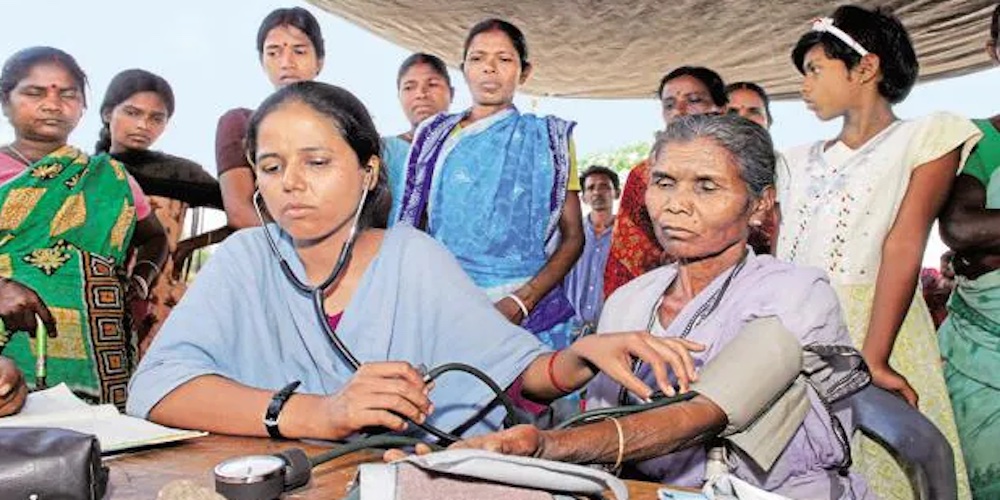Health for All

The Modi government asserts that it has taken multiple steps to strengthen the public healthcare system in the country to provide accessible and affordable health services to all citizens
According to the Government of India, the National Health Mission (NHM) envisages achievement of universal access to equitable, affordable & quality healthcare services that are accountable and responsive to people’s needs. NHM encompasses its two Sub-Missions, the National Rural Health Mission (NRHM) and the National Urban Health Mission (NUHM). The main programmatic components include Health System Strengthening in rural and urban areas, Reproductive-Maternal-Neonatal-Child and Adolescent Health (RMNCH+A), Health Systems Strengthening, and Communicable and Non-Communicable Diseases.
In February 2018, the Government of India announced the establishment of 1,50,000 Ayushman Arogya Mandirs (AAMs), erstwhile Ayushman Bharat Health and Wellness Centres (AB-HWCs), across the country by December 2022. A total of 1,77,906 Ayushman Arogya Mandirs have been established and operationalized as on 30th June 2025, by transforming existing Sub-Health Centres (SHC) and Primary Health Centres (PHC) in rural and urban areas to deliver the expanded range of comprehensive primary healthcare services with complete 12 package of services that includes preventive, promotive, curative, palliative and rehabilitative services which are universal, free, and closer to the community.
Pradhan Mantri Ayushman Bharat Health Infrastructure Mission (PM-ABHIM) is a Centrally Sponsored Scheme (CSS) with some Central Sector Components (CS), which has an outlay of Rs. 64,180 Crores for the scheme period (2021-22 to 2025-26). The measures under the PM-ABHIM focus on developing capacities of health systems and institutions across the continuum of care at all levels–primary, secondary, and tertiary– to prepare health systems in responding effectively to the current and future pandemics/disasters. Administrative approvals have been accorded to States/UTs for FY 2021-26 for an amount of Rs. 33,081.82 Crore for the construction/strengthening of 10609 Building less-AAMs, 5456 Urban-AAMs, 2151 Block Public Health Units (BPHUs), 744 Integrated Public Health Labs (IPHLs) at the District level, and 621 Critical Care Blocks (CCBs).
Ayushman Bharat Pradhan Mantri-Jan Arogya Yojana (AB PM-JAY) is a flagship scheme of the Government which provides health cover of Rs. 5 lakh per family per year for secondary and tertiary care hospitalization to 12 crore families, constituting the economically vulnerable bottom 40% of India’s population. On 29.10.2024, the scheme was further extended to cover 6 crore senior citizens aged 70 years and above, representing 4.5 crore families, through the Vay Vandana Card, irrespective of their socio-economic status.
The Ministry of Health and Family Welfare has launched various digital initiatives. One of the major initiatives is Ayushman Bharat Digital Mission (ABDM), launched in September 2021. ABDM aims to create an online platform enabling interoperability of health data within the health ecosystem. The aim of this mission is to create an Electronic Health Record (EHR) of every citizen. ABDM envisages developing the backbone necessary to support the integrated digital health infrastructure of the country. The core components of the Mission include Ayushman Bharat Health Account (ABHA) for citizens, Health Professional Registry (HPR), Health Facility Registry (HFR), and ABHA Application. The digital health ecosystem created by ABDM supports continuity of care across primary, secondary, and tertiary healthcare in a seamless manner.
The Pradhan Mantri Swasthya Suraksha Yojana (PMSSY) aims to correct regional imbalances in the availability of affordable tertiary healthcare services and to augment facilities for quality medical education in the country. The scheme has two components, namely, (i) setting up of All India Institute of Medical Sciences (AIIMS), (ii) Upgradation of existing Government Medical Colleges/Institutions (GMCIs). So far, the setting up of 22 new AIIMS and 75 projects of upgradation of GMCIs have been approved under the scheme in various phases.

The government has increased the number of Medical Colleges, Undergraduate (UG) and Postgraduate (PG) seats. There is an increase in Medical Colleges from 387 to 780; UG seats from 51,348 to 1,15,900, and PG seats from 31,185 to 74,306 from 2014 to date.
It may be noted that overall the healthcare infrastructure of the country involves a three-tier system with Sub Health Centre (Rural), Primary Health Centre (Urban and Rural) and Community Health Centre (Urban and Rural) as the three pillars of the Primary Health Care System in India. National Health Mission (NHM) envisages achievement of universal access to equitable, affordable and quality health care services that are accountable and responsive to the needs of the population, including OBC, SC and ST populations.
As per established norms, in rural areas a Sub Health Centre for a population of 5,000 (in plain) and 3000 (in hilly and tribal area), a Primary Health Centre for a population of 30,000 (in plains) and 20,000 (in hilly and tribal areas) and Community Health Centre for a population of 1,20,000 (in plain) and 80,000 (in hilly and tribal area) is suggested. Further, for urban areas, one Urban Ayushman Arogya Mandir is recommended for an urban population of 15,000 to 20,000, one Urban-Primary Health Centre (U-PHC) for an urban population of 30,000 to 50,000, one Urban-Community Health Centre (U-CHC) for every 2.5 lakh population in non-metro cities (above 5 lakh population), and one U-CHC for every 5 lakhs population in the metro cities.
The population norms for setting up SHCs, PHCs and CHCs in tribal and hilly areas have been relaxed from 5,000, 30,000, and 1,20,000 to 3000, 20,000, and 80,000, respectively.
Under NHM, the following types of incentives and honorarium are provided for encouraging Health Specialists to practice in different regions of the country, including rural and remote areas of the country:
• Hard area allowance to specialist doctors for serving in rural and remote areas and for their residential quarters so that they find it attractive to serve in public health facilities in such areas.
• Honorarium to Gynaecologists/ Emergency Obstetric Care (EmoC) trained, Paediatricians & Anaesthetists/ Life Saving Anaesthesia Skills (LSAS) trained doctors is also provided to increase availability of specialists for conducting Caesarean Sections in rural & remote areas.
• Incentives like special incentives for doctors, incentives for ANM for ensuring timely ANC checkup and recording, incentives for conducting Adolescent Reproductive and Sexual Health activities.
• States are also allowed to offer negotiable salaries to attract specialists, including flexibility in strategies such as “You Quote We Pay”.
• Non-monetary incentives such as preferential admission in post-graduate courses for staff serving in difficult areas and improving accommodation arrangements in rural areas have also been introduced under NHM.
• Multi-skilling of doctors is supported under NHM to overcome the shortage of specialists. Skill upgradation of existing HR is another major strategy under NRHM for achieving improvement in health outcomes.
Mobile Medical Units (MMUs) provide primary healthcare services to remote, tribal, and underserved populations, which also include OBC, SC, and ST populations. These MMUs function as mobile clinics, delivering preventive, promotive, and curative healthcare to areas lacking easy access to hospitals or health centers. As per NHM MIS December 2024, there are a total of 1498 MMUs operational in the country, including OBC, SC, and ST population areas under NHM. Out of these 1498 MMUs, a total of 694 MMUs are currently operational in areas with Particularly Vulnerable Tribal Groups (PVTGs), providing both preventive and curative care.
Through the National Health Mission (NHM), the government has implemented various programs to improve maternal and child health services and outcomes, including OBC, SC and ST populations throughout the country. These initiatives to reduce Maternal Mortality Rate (MMR) and Infant Mortality Rate (IMR) include Janani Suraksha Yojana (JSY), Janani Shishu Suraksha Karyakram (JSSK), Surakshit Matritva Aashwasan (SUMAN), Pradhan Mantri Surakshit Matritva Abhiyan (PMSMA), Mothers’ Absolute Affection (MAA), Setting up of Maternal and Child Health (MCH) Wings, Birth Waiting Homes (BWH), Anaemia Mukt Bharat (AMB), Facility-Based Newborn Care, Kangaroo Mother Care (KMC), Community-based care of Newborn and Young Children, STOP Diarrhoea initiative, Nutrition Rehabilitation Centres (NRCs), and Universal Immunization Programme (UIP).


